How Do You Know When a Loop Is Over Python
Sympathise Loops in Python with One Article
Later reading this commodity, there will exist no adventure Loops will always throw yous for a Loop
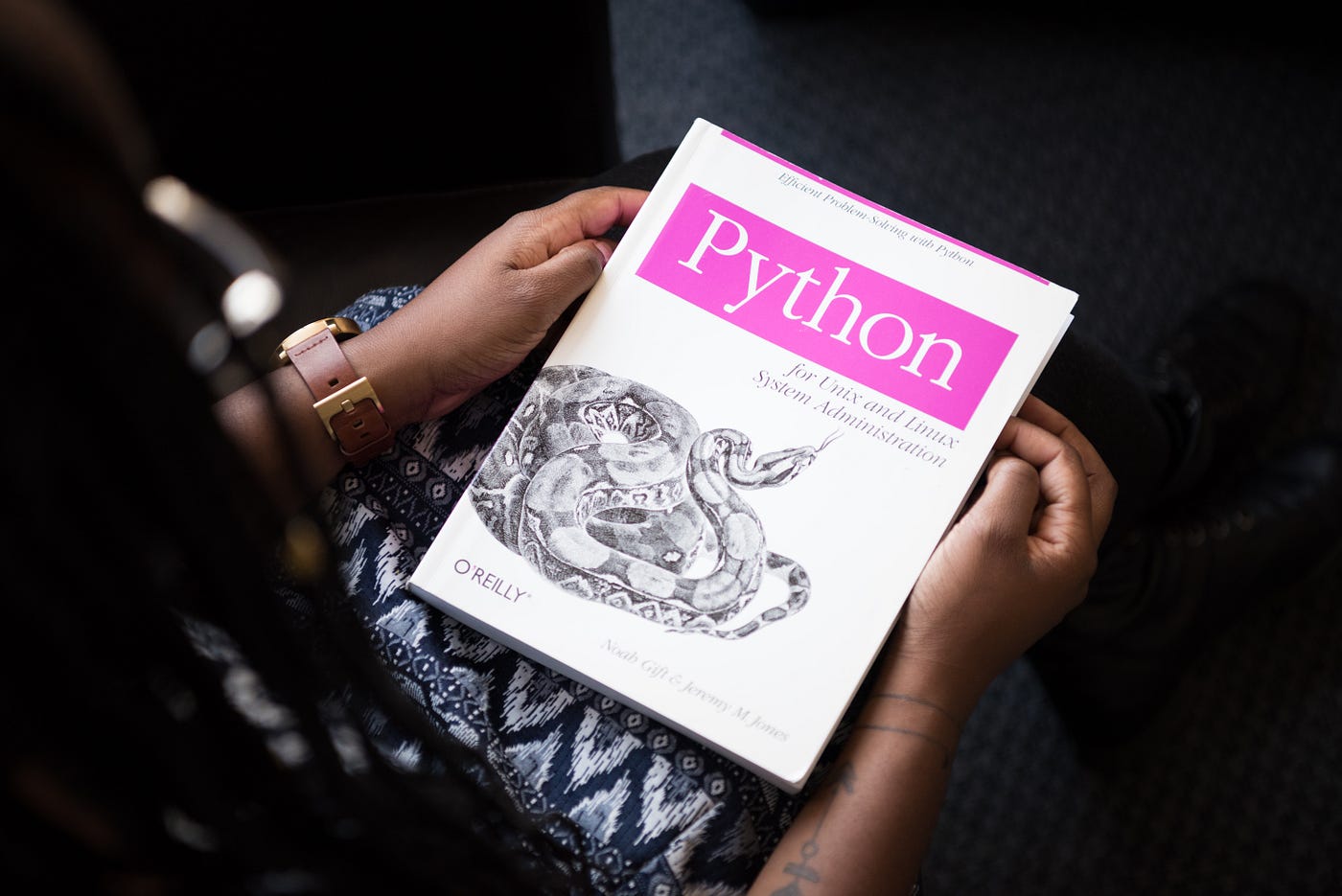
Computers are cracking at performing repetitive tasks over and over, as they never "get bored" or make mistakes. A elementary adding requested to a computer could be performed one or a yard times, and the first result volition exist as accurate every bit the last 1. This is something humans are not capable of guaranteeing.
Being able to consul the automation of routinary tasks to computers is an invaluable skill which every programmer should master in order to improve their coding skills and code accuracy.
The number of tasks available to perform with the help of loops ranges from copying files to a grouping of computers on the network, sending personalized emails to certain users or verifying that a process is still running.
It doesn't matter the complexity of the chore, the computer will perform information technology as many times as you tell, which more importantly, leaves you more time to spend with more interesting activities.
In Python, Loops can be me implemented in three ways:
- "While" Loops
- "For" Loops
- Recursion
During this commodity, I'll explicate these techniques considering that each one takes a slightly different approach. Y'all'll acquire how to write the code and how to understand when to use one technique instead of the others.
Tabular array of contents:
1. While Loops (4 min read)
2. For Loops (4 min read)
iii. Recursion (3 min read)
1. While Loops
This technique instructs the computer to continuously execute a code based on the value of a condition. Information technology begins with the keyword while, followed by a comparison to exist evaluated, then a colon. On the next line is the lawmaking cake to exist executed, indented to the right. Similar to an if statement, the code in the body volition but be executed if the comparison is evaluated to exist true.
What sets a while loop apart, yet, is that the code block will continue executing every bit long as the evaluation statement is truthful. One time the argument is no longer true, the loop exits and the adjacent line of code will be executed.
Take a expect a the post-obit instance:
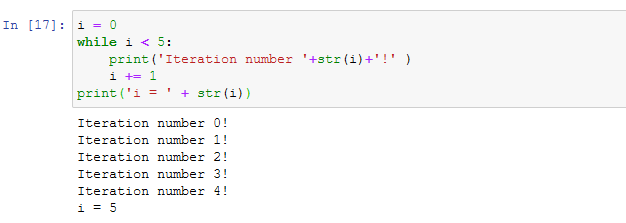
Allow's go through each line of code inside this loop:
- In the commencement line nosotros're assigning the value of 0 to the variable "i", named later the discussion "iteration". This action is called "initializing", in order to give an initial value to a variable.
- In the line later that, we're starting the while loop. Nosotros're setting a status for this loop that "i" needs to be smaller than 5. Right now, "i" is 0 since it'due south only been initialized, then this condition is currently true.
- On the next two lines, we have a block that's indented to the correct. Here, we tin can use the characteristic shared with Python functions, which indicates that every line of lawmaking that shares the same amount of indented spaces will be part of the body of the part, or loop in this case.
- There are two lines in the body of the loop. In the first line, we print a message followed by the electric current iteration, represented by the value of "i". In the second line, the value of "i" is incremented. We practice this by adding i to its current value and assigning it back to "i". So afterward the commencement execution of the torso of the loop, "i" will be one instead of 0.
Because this is a loop, the computer doesn't only continue executing with the next line in the script. Instead, it loops back around to re-evaluate the condition for the while loop.
And because 1 hither is still smaller than 5, information technology executes the body of the loop once again. The computer will proceed doing this until the status isn't true anymore. In this instance, the status will be false when "i" is no longer smaller than 5. One time the condition is False, the loop finishes, and the next line of the lawmaking is executed.
Avoiding the Space Loop trap

As previously told, while loops employ the condition to check whether to get out from the loop structure. The body of the while loop needs to brand sure that the status being checked will alter. If it doesn't change, the loop may never terminate and we get what'due south called an infinite loop, a loop that keeps executing and never stops.
Accept the following code equally an example. As in the previous example, we initialized the "i" variable, just forgot to add an alphabetize inside the loop to refresh the variable in each iteration. Every bit a consequence, the loop will run until we manually interrupt it with the CTRL+C commands:
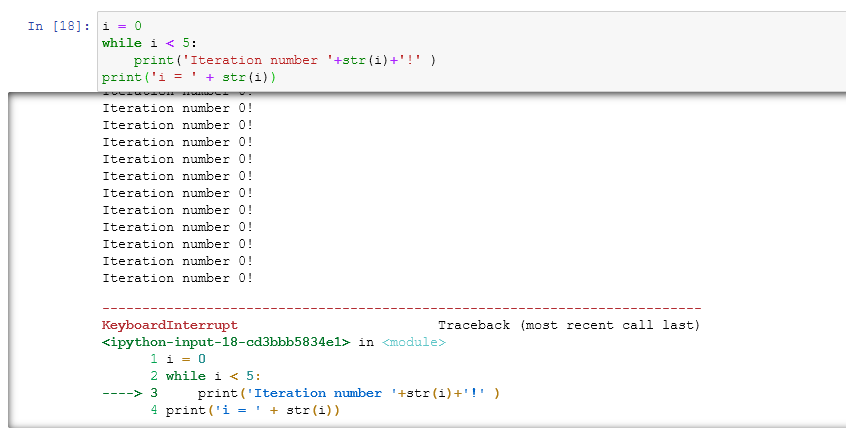
In order to avoid this issue, information technology's a skillful idea to take a moment to consider the unlike values a variable tin can take. This helps you make sure the loop won't get stuck during the iteration.
Should you always try to avoid infinite loops?
While you need to sentinel out for space loops, they are not ever a bad thing.
Sometimes you actually want your program to execute continuously until some external condition is met.
If y'all've used the ping utility on Linux or macOS system, or ping-t on a Windows system, y'all've seen an infinite loop in action. This tool will keep sending packets and printing the results to the final unless yous ship it the interrupt signal, usually pressing Ctrl+C.
In Python, we usually create our loops with an automatic indication to interrupt the iteration with the keyword suspension , which you lot can see in the code beneath, to signal that the current loop should finish running:

As you tin can come across, the indicated procedure was to add 1 to the variable "i" for each iteration, until it reaches a value of 10, when it should interrupt the process. The logic of the lawmaking would be something like this:

two. For Loops
A for loop iterates over a sequence of values. A very uncomplicated case of a for loop is to iterate over a sequence of numbers, for example from 0 to 4.

Notice that the structure is kind of like to the structures of while loops. The offset line indicates the distinguishing for keyword and it ends with a colon. The body of the loop is indented to the right, like in the while loop, the if block, and the function definitions. What's different in this case is that we have the keyword in.
Also, betwixt the for keyword and in keyword, nosotros have the name of a variable, in this instance "i" for "alphabetize". This variable will have each of the values in the sequence that the loop iterates through. And then in this example, it'll iterate through a sequence of numbers generated using the range() role.
Equally a reminder, in Python and a lot of other programming languages, a range of numbers will start with the value 0 by default. In addition, the listing of numbers generated will be one less than the given value. In the simple instance hither, "i" will take the values 0, 1, ii, iii, and 4.
At this signal in the article you lot might be wondering: Why have two loops that look like they exercise the same thing?
Well, the power of the for loop is that nosotros can use it to iterate over a sequence of values of any blazon, not just a range of numbers. For example, nosotros tin iterate over a listing of string or words:

The sequence that the for loop iterates over could contain any type of element, not just strings. For instance, nosotros could iterate over a list of numbers to summate the total sum and average.

In this case, we're defining a list of values. After that, we're initializing two variables, some and length, that will update in the body of the for loop. In the for loop, we're iterating over each of the values in the list, calculation the current value to the sum of values, so also adding 1 to length, which calculates how many elements there are in the listing. Once we've gone through the whole list, we print out the sum and the average.
We'll continue using for loops in our examples every time we desire to iterate over the elements of any sequence and operate with them.
How do you place which loop to use?
If you're wondering when y'all should employ for loops and when you should apply while loops, there's a mode to tell:
- Utilize for loops when there's a sequence of elements that y'all want to iterate.
- Use while loops when you want to repeat an action until a condition changes.
And if any yous're trying to do can be washed with either for or while loops, just utilise whichever one's your favorite.
Level upwardly your looping skills: Nested Loops
Basically, a Nested Loop is a one or more for loops inside another loop. For example, suppose that you have to fix the schedule for a tennis tournament with four of our favorite players that will play against each other.
To prepare our schedule, let's sort the players with a Python script that will output all possible match pairings. For this, the club of the names matters because for each game, the get-go name will be the one player and the second proper name will be the contender. Of course, what we don't want to do is have a role player against itself. To do this, we need to employ a conditional that makes sure we simply impress the pairing when the names are dissimilar.
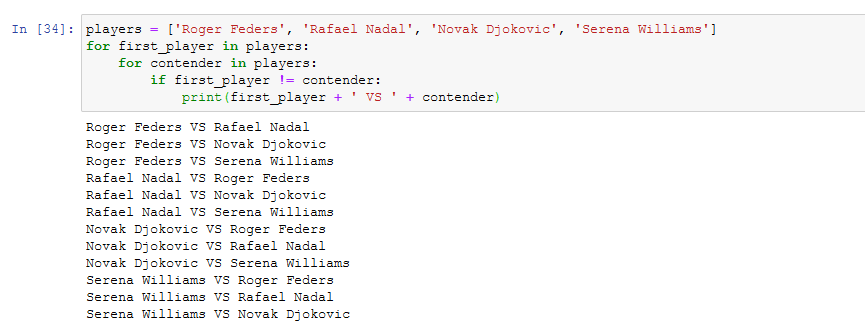
As y'all tin meet, Nested Loops are very useful for solving certain problems, such as sorting players in a tournament.
Mutual Mistakes with Loops
- Iterating over non-sequences: As I've mentioned already, for loops iterate over sequences. Consequently, Python's interpreter volition refuse to iterate over single elements, such equally integers or non-iterable objects.
- Failure to initialize variables. Brand sure all the variables used in the loop's status are initialized before the loop.
- Unintended space loops. Brand sure that the body of the loop modifies the variables used in the status, then that the loop volition somewhen end for all possible values of the variables.
- Forgetting that the upper limit of a range() isn't included.
As a practical example of the showtime scenario, allow'southward try to iterate an integer:

There are two solutions to this trouble, depending on what nosotros're trying to do:
- If you want to go from nix to 25, then we use the range function.
- If y'all're trying to iterate over a list that has 25 as the but element, then it needs to be a list.
iii. Recursion
Recursion is the third mechanism in Python to loop through a sequence of values in addition to while and for loops.
While Recursion is a very common technique used in software engineering, it'due south non much used in automation tasks. Still, it's valuable to know most it every bit y'all might encounter it in someone else's code or, even more importantly, you might face up a problem where recursion is the best way to solve it.
Recursion is the repeated awarding of the same procedure to a smaller trouble.
A swell visual example for these methods are Russian nesting dolls:

As yous might see, each doll has a smaller doll inside it. When you open up up the doll to observe the smaller one inside, you continue going until you reach the smallest doll which tin can't be opened. Recursion lets usa tackle complex problems by reducing the problem to a simpler i.
Imagine that we want to discover how many dolls at that place are in total, we would need to loop over each doll until we get to the last 1 and then count how many dolls we've opened. That's recursion in action.
In programming, recursion is a way of doing a repetitive task by having a function call itself. A recursive function calls itself normally with a modified parameter until it reaches a specific condition. This condition is called the base case.
In the Russian dolls example, the smallest doll would be the base of operations case. Let's effort a real-life problem, in which we'll endeavour to lawmaking a role that calculates the factorial of a number. In mathematics, the factorial of a positive integer north, denoted by northward!, is the product of all positive integers less than or equal to n:
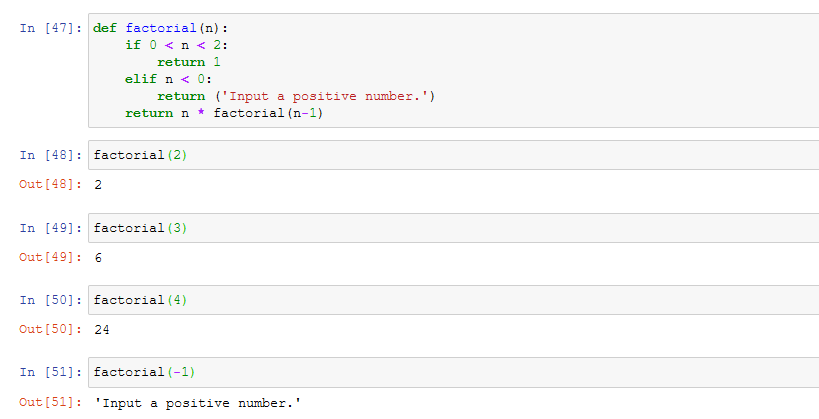
As you tin meet in the code above, the role factorial() calls itself in order to solve factorials for numbers greater than i. Each time the role is executed, information technology calls itself with a smaller number until it reaches the base case. Once information technology reaches the base case, information technology returns the value ane. This loop will keep going until the first factorial() function returns the desired effect.
You might be wondering why do we demand recursive functions if I can merely use a for or while loop?
Because solutions to some specific issues are easier to write and empathize when using recursive functions. For example, for IT specialists trying to automate tasks, recursion would exist a useful tool to inspect a computer's directory as each directory will contain sub-directories which contain files.
The base of operations case would be a directory with no sub-directories. For this instance, the function would just render the amount of files, but for the remaining sub-directories it would phone call the recursive function. When operating with recursive structures, it's ofttimes easier to apply recursive functions instead of for or while loops.
It's of import to call out that in some languages there'due south a maximum amount of recursive calls you can use. In Python by default, you can phone call a recursive part 1,000 times until you reach the limit. That'south fine for things like sub-directories or similar recursive structures.
Decision
In this commodity I explained how to tell a computer to practice an activeness repetitively. Python gives us three different ways to perform repetitive tasks: while loops, for loops, and recursion.
For loops are best when you want to iterate over a known sequence of elements merely when you lot want to operate while a sure condition is truthful, while loops are the best selection.
If you lot liked the information included in this article don't hesitate to contact me to share your thoughts. It motivates me to keep on sharing!
Related articles for farther insights to Python Programming:
Creating stock's price simulator:
Learn how to code amazing visualizations in Python:
Information Assay of New York with Python:
Thanks for taking the time to read my article! If you have any questions or ideas to share, please feel free to contact me to my email, or you can detect me in the following social networks for more related content:
- LinkedIn .
- GitHub .
Source: https://towardsdatascience.com/understand-loops-in-python-with-one-article-bace2ddba789
Post a Comment for "How Do You Know When a Loop Is Over Python"